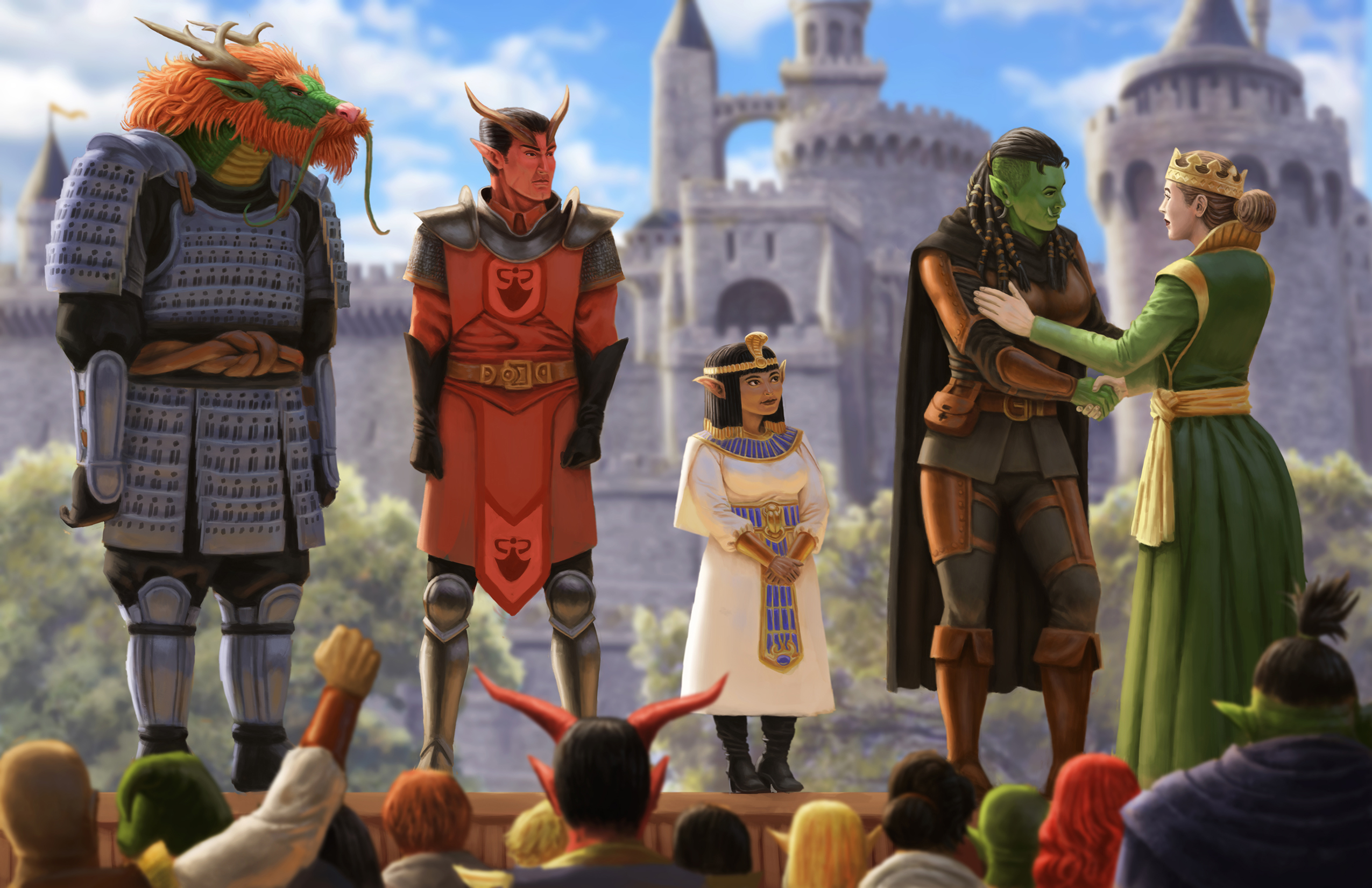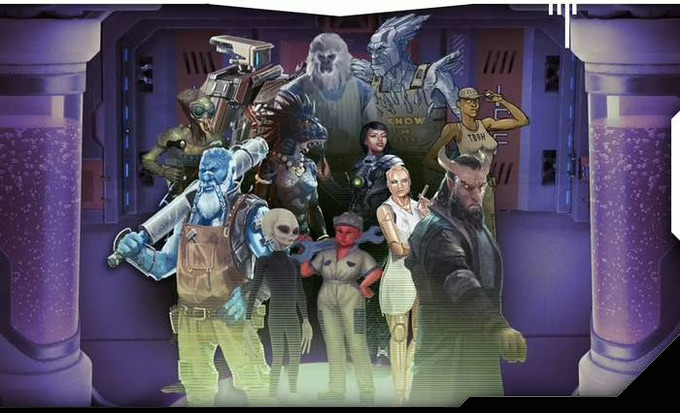Half-Dragon Template
Half-Dragon Template
A beast, humanoid, giant, or monstrosity can become a half‑dragon. It keeps its statistics, except as follows.
Languages. If the half-dragon knows languages, it speaks Draconic in addition to the ones it knows.
Senses. The half-dragon gains blindsight out to a distance of 10 feet and darkvision out to a distance of 60 feet.
Resistances. The half-dragon gains resistance to a damage type dealt by the breath weapon of its dragon half.
Breath Weapon. The half-dragon uses the Breath Weapon attack of the oldest dragon of its type that has a Challenge Rating equal to or lower than the half-dragon’s Challenge Rating (minimum wyrmling).
Wings. If the half-dragon’s Challenge Rating is 9 or higher, it gains wings and a fly speed of 60.
Dragon Lich Template
Dragon Lich Template
Some dragons seek to defy death, becoming undead dragon liches. Such a dragon channels its inherent magical nature into an arcane spark that grants it a semblance of life beyond death. Scales and flesh slough off the dragon lich, eventually leaving nothing but a skeletal dragon brooding over moldering treasure.
In order to become a dragon lich, a dragon must imbue its spirit into a soul vessel. The vessel is usually some treasured item from the dragon’s hoard, such as a particularly valuable gem or piece of jewelry. The dragon can’t bear to be apart from its soul vessel and keeps it close among its hoard. The only way to permanently defeat a dragon lich is to destroy both the dragon and the soul vessel.
Any adult or older dragon with spellcasting ability may become a dragon lich. Chromatic dragons most often become dragon liches. A dragon lich retains all the statistics of the original dragon except as noted below.
Type. The dragon’s type is Undead (dragon).
Breath Weapon. When the dragon uses a breath weapon that deals damage, half of its damage is the original damage type and half is necrotic damage.
Expanded Spell List. The dragon can cast animate dead with no material components three times per day. An ancient or older dragon can cast create undead with no material components three times per day.
Immunities. The dragon gains immunity to necrotic and poison damage. It can’t be charmed , fatigued , frightened , paralyzed , or poisoned .
The dragon lich’s Legendary Resistance trait is replaced with the following:
Legendary Resistance (3/Day). When the dragon fails a saving throw , it can choose to succeed instead. When it does, it loses its Undead Telepathy trait until the end of its next turn. Until the end of its next turn, undead creatures under its control are incapacitated .
The dragon lich gains the following traits:
Rejuvenation. If it has a soul vessel, a destroyed dragon lich gains a new body in 1d10 days, regaining all its hit points. The new body forms within 10 feet of the soul vessel.
Turn Resistance. The dragon lich has advantage on saving throws against any effect that turns undead.
Undead Nature. A dragon lich doesn’t require air, sustenance, or sleep.
Undead Telepathy. The dragon lich can communicate telepathically with undead creatures within 120 feet.
Cultures
Cultures
Destinies
Destinies
Heritages
Heritages

| Heritage | >Description | Source |
| Birdfolk | Winged, feathered avians able to glide or fly. | Gate Pass Gazette #5 |
| Cervid | Humanoid deerfolk, fleet of foot with mighty antlers | Gate Pass Gazette #11 |
| Chrysalian | Diminutive, insectoid fey that hail from the Dreaming. |
Gate Pass Gazette #15 |
| Constructed | Artificial beings powered by a renewable energy source. | Gate Pass Gazette #0 |
| Dragonborn | Draconic humanoids with deadly breath weapons. | Adventurer's Guide |
| Dreamborn | Fey folk with deep ties to the Dreaming. | Gate Pass Gazette #4 |
| Dryadborn | Those with ties to both dryads and mortals. | Gate Pass Gazette #26 |
| Deva | Reincarnated immortals with memories of past lives. | Adventures in ZEITGEIST |
| Doppelgänger | Shapechangers who can adopt the appearance of others. | Dungeon Delver's Guide |
| Dwarf | Hardy, long-lived folk with an innate ability to build. | Adventurer's Guide |
| Elf | Ancient beings with supernatural grace. | Adventurer's Guide |
| Galeoni | Shark-people with powerful jaws. | Gate Pass Gazette #9 |
| Garoul | Wolf-people with hunting instincts and a connection to the wild. | Gate Pass Gazette #8 |
| Gnoll | Humanoid hyenas with strong jaws. | Adventures in ZEITGEIST |
| Gnome | Diminutive folk with innate magic. | Adventurer's Guide |
| Goblin | Small, nimble goblinoids often reviled by others. | Adventures in ZEITGEIST |
| Halfling | Brave folk who stand 3-feet tall. | Adventurer's Guide |
| Human | Short-lived people with great potential. | Adventurer's Guide |
| Kobold | Small, reptilian humanoids known as clever tricksters. | Adventures in ZEITGEIST |
| Lizardfolk | Cold-blooded reptilian humanoids. | Adventures in ZEITGEIST |
| Madrai | Dog-people who aren't great at bluffing at cards | Gate Pass Gazetter #14 |
| Minotaur | Humanoids with cloven hooves and the head of a bull. | Adventures in ZEITGEIST |
| Motley | Patchwork folk with animal features. | Dungeon Delver's Guide |
| Mycelial | Small fungus-folk resembling capped mushrooms. | Dungeon Delver's Guide |
| Oozefolk | Jelly-like humanoids able to morph their shape. | Dungeon Delver's Guide |
| Oxfolk | Bovine-esque people with large, curving horns. | Gate Pass Gazette #16 |
| Orc | Strong, tusked humanoids with primal instincts. | Adventurer's Guide |
| Pantheran | Wildcat-like people from a range of climates. | Gate Pass Gazette #28 |
| Planetouched | Mortal beings with the immortal ancestry of fiends or angels. | Adventurer's Guide |
| Planetouched: Elementaari | Mortal beings with the immortal ancestry of genies and other elementals | Gate Pass Gazette #18 |
| Pode | Octopus-like people with multiple tentacles. | Gate Pass Gazette #9 |
| Ratling | Rodent-like humanoids with an unknown origin. | Dungeon Delver's Guide |
| Rockborn | Powerful folks made of stone. | Dungeon Delver's Guide |
| Shadowcast | Creatures who are reflections of a counterpart on the material plane | Gate Pass Gazette #23 |
| Spiderfolk | A mysterious arachnoid people with extra arms. | Gate Pass Gazette #3 |
| Trollkin | Relations to the many kinds of troll. | Gate Pass Gazette #24 |
| Zevite | Outsiders from the astral planes who believe in living life to the fullest | Gate Pass Gazette #13 |
Voidrunner Heritages

| Heritage | >Description | Source |
| Android | Artificial beings with a variety of configurations. | Voidrunner's Codex |
| Axon | Large, furry, bipedals known for their great strength. | Voidrunner's Codex |
| Grey | Small cerebral aliens who possess innate psionic powers. | Voidrunner's Codex |
| Houseki | Crystalline entities which grow all through their lifespan. | Voidrunner's Codex |
| Human | Short-lived people with great potential. | Voidrunner's Codex |
| Hurroc | Fierce, horned folk with evolved adrenal glands. | Voidrunner's Codex |
| Keridani | Psionic insectoids. | Voidrunner's Codex |
| Naato | Reptilian species with scales and a tail. | Voidrunner's Codex |
| Sipher | Small hiveminded folk with innate links to planetary bodies. | Voidrunner's Codex |
Spinner Cult
Spinner Cult
While some Spinner cults are isolationist, just as many have woven themselves and their families into the thread of large cities. Regardless, such acolytes were pressured to be constantly alert to any small omen or sign of prophecy and to take them very seriously, and this pressure most likely still sticks with them long afterwards.
These cults are almost always started by a central figure who claims to have received a vision from the Fate Spinner herself. In rare cases,they may have even crossed over accidentally into the Silver Hollows and been sent back on a mission from the Fate Spinner or have communicated with one of her servants, such as a fateholder . Just as often, however, these central figures have no genuine tie to the Mother of Law and build the cult with the presumption that their devotion in starting a cult will be rewarded with visions. A member’s relationship to this central figure, who may have even changed or been replaced over their time in the cult, will heavily reflect their feelings on this past.
These cults are often cutthroat and confrontational. Those who follow the Fate Spinner know that only a slim fraction of them truly have a kind fate to look forward to, and as such, they sabotage one another and compete ruthlessly in search of signs that will prove they are one of the lucky few who will reach enlightenment. In truth, this prophecy is often self-fulfilling, as their willingness to sell one another out is most often their downfall. Much as large groups of spiders will devour one another, Spinner cults are held back by their own infighting.
Characters raised in spinner cults share a variety of traits in common with one another.
Necessary Skills. Survival in these cults is often dependent on the individual’s ability to spot even the flimsiest supposed omen and to anticipate (or obfuscate) betrayal. You gain proficiency in either Deception or Insight and either Investigation or Perception.
Cold Read. Getting ahead in Spinner cults often involves a carefully-applied mix of trickery and showmanship to appear prescient. When you first meet someone new and interact with them personally for at least 1 minute, you can ask the Narrator one question about them. This question must be a surface-level question about their personality or life, such as “do they have children?”, “what do they think of the Duke?”, or “what do they want right now?”. You have advantage on the next Deception, Persuasion or Insight check you make that uses this knowledge to benefit you.
Discreetly Armed. Even while armed, you know how to be discreet and nonthreatening. You gain an expertise die on checks made to persuade others to let you remain armed or to conceal weapons or items about your person.
Oracular Talent. You know one Divination cantrip or 1st-level Divination spell of your choice. If you choose a 1st-level spell, you can cast it once without spending a spell slot or providing material components, and must finish a long rest before you can do so again. Your spellcasting ability for this spell is Intelligence or Wisdom (whichever is highest).
Languages. You speak, read, write and sign in Common and Undercommon
